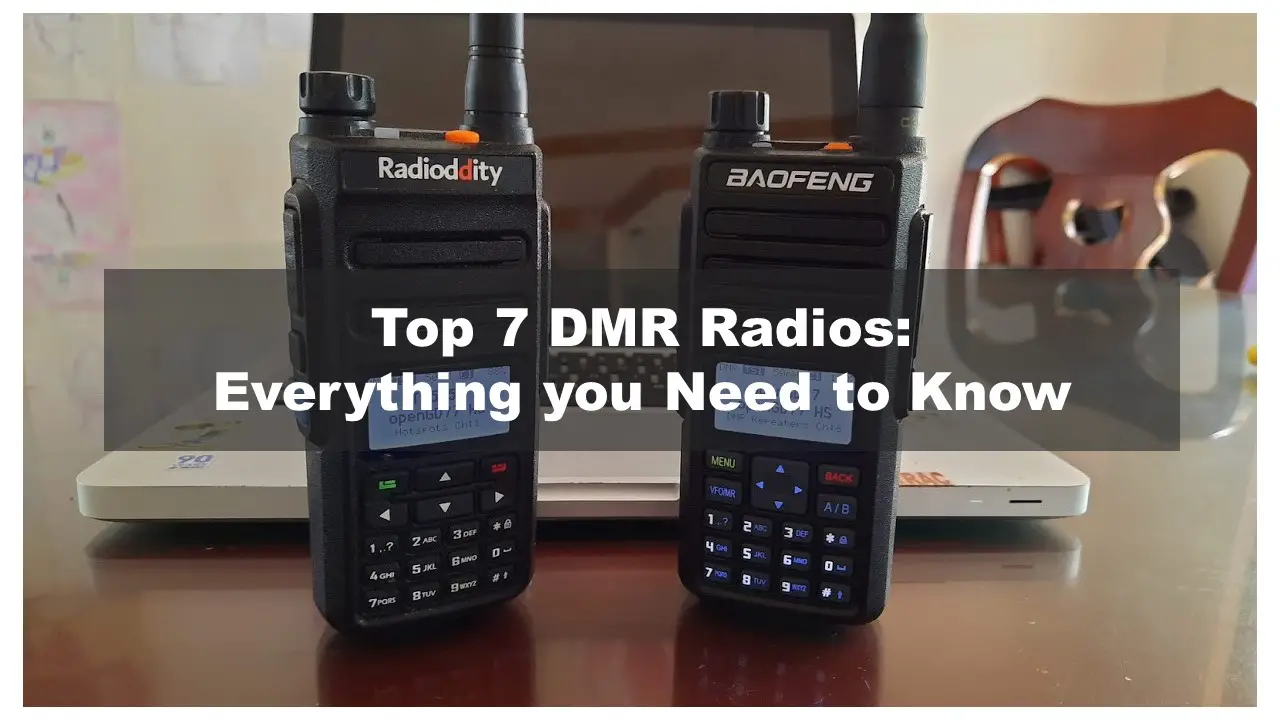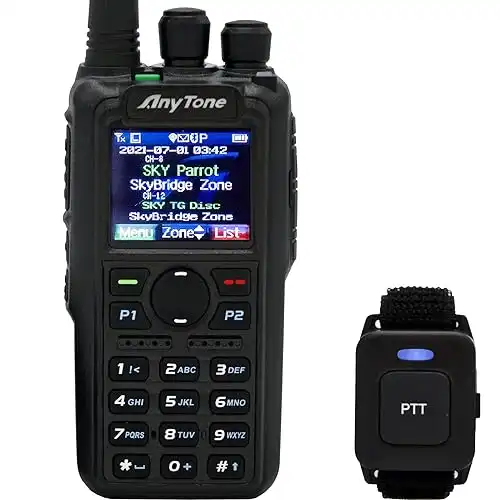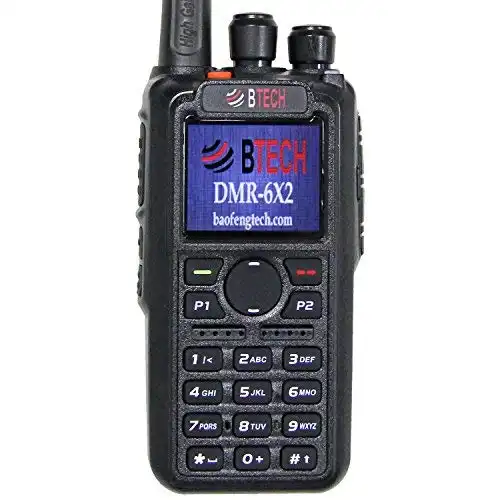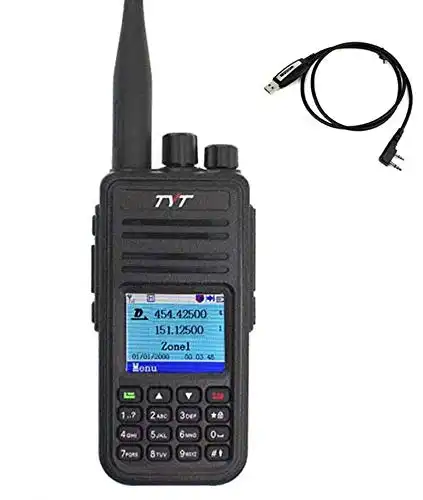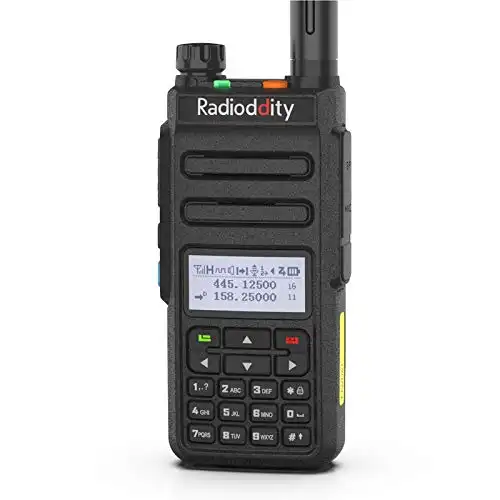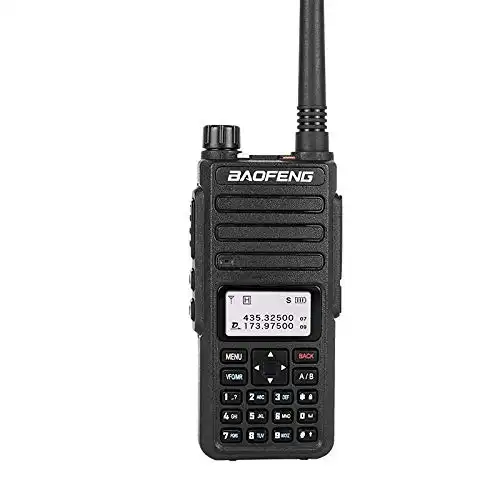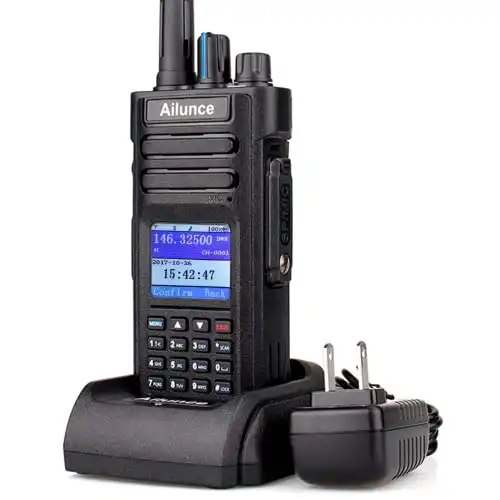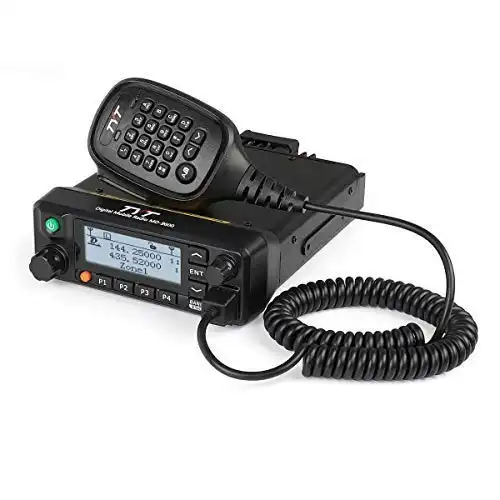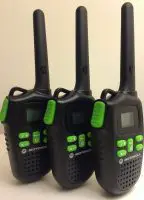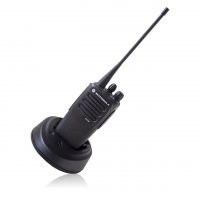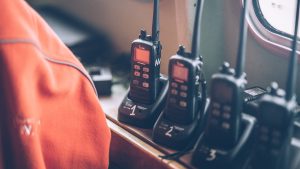If you’re looking for the best DMR radios, you’ve come to the right place. This blog post will discuss what makes a great DMR radio and list our top 7 favorites.
We’ll also review some features you should look for when purchasing a DMR radio. So whether you’re just starting in digital mobile radio or looking for an upgrade, read on for the inside scoop!
Table of Contents
What is a DMR (Digital Mobile Radio)?
A DMR (Digital Mobile Radio) is an open standard or protocol for digital mobile radios. It’s based on the European Telecommunications Standards Institute (ETSI) TETRA (Terrestrial Trunked Radio) standard, which defines how radio systems should be designed to meet the needs of public safety organizations and other government agencies.
DMR is a two-way digital radio system communicating voice and data between users. It offers group calling, Private Calls, and Text Messages, allowing users to communicate more efficiently. In addition, digital radios can also interface with computers and other communications devices to provide enhanced functionality.
3 Tiers Of DMRs (Digital Mobile Radios)
There are 3 tiers of DMRs:
- DMR I – Non-licensed conventional.
- DMR II – Licensed conventional.
- DMR III – trunking.
Let’s take a closer look!
DMR I – Non-licensed conventional.
A DMR I – Non-licensed conventional is a simplex radio frequency channel that uses just two radios to communicate with each other. This type of communication is typically used on public frequencies, such as the VHF and UHF bands. Because no license is required, this communication mode is popular among amateur radio enthusiasts.
Key benefits
- No license required
- Multiple access
- Cheaper equipment
- Easy to use
DMR II – Licensed conventional.
A DMR II license is a type of FCC license that allows users to operate conventional two-way radios on the 66 to 960 MHz frequency band. These licenses are typically used by businesses, schools, and other organizations that need two-way radios for communication purposes.
Key benefits
- Secured communication
- More powerful radios
- Better sound quality
DMR III – Trunking.
A DMR III Trunking system is a digital trunked radio system developed from the ETSI DMR open standard. It is an IP-based digital trunked platform that provides enhanced reliability, scalability, and security for mission-critical communications.
Key benefits
- Secure communication
- Better scalability
- Increased reliability
Uses Of DMRs
DMR radios are used in various commercial and public safety communication applications. Here are some popular uses:
- Business-wide communication: DMR radios are used in businesses to provide reliable and secure communication across multiple sites.
- Emergency response: Public safety personnel rely on DMR radios to respond quickly and appropriately in a crisis.
- Amateur radio enthusiasts: Amateur radio hobbyists use DMR radios for their superior range and better audio quality compared to other radios.
- Amateur radio contests: DMR radios are commonly used in amateur radio contests, as they provide an advantage due to their superior performance capabilities.
Top 7 Best DMR Radios
#1. AnyTone AT-D878UVII Plus
Introducing the AnyTone AT-D878UVII Plus radio – a perfect companion for your expeditions! Whether you’re a ham radio operator, trekker extraordinaire, or everyday adventurer, this high-powered radio provides many features to keep you connected.
With excellent frequency ranges in V and U bands that cover a wide range of regions and 4000 channels supported by the 7.4V DC 2100mAh battery, you’re guaranteed seamless communication with other operators worldwide.
The wide channel spacing/bandwidth of 25KHz (WideBand) and 12.5KHz (NarrowBand) give you an expansive coverage of tones required to connect effectively with others. And thanks to its phase-locked step of 5KHz, 6.25KHz, interference caused by electric noise is minimized.
Go ahead and explore – filled with reliable performance in harsh weather conditions from -20℃~ +55℃ and pushing new boundaries with this rugged AnyTone AT-D878UVII Plus Radio!
Pros
- Best handie-talkie DMR
- 2 independent time slots
- High-powered
- 4000 channels supported by a 7.4V DC 2100mAh battery
- Wide channel spacing/bandwidth of 25KHz (WideBand) and 12.5KHz (NarrowBand)
- Phase locked step of 5KHz, 6.25KHz to reduce electric noise interference
Cons
- Expensive
#2. BTECH DMR-6X2 Dual-band DMR HT
Are you looking for a high-quality and reliable dual-band DMR mobile phone? Look no further than the BTECH DMR-6X2. This reliable and rugged radio is perfect for businesses and individuals who need a dependable, long-range communication solution.
Our DMR-6X2 features 4000 channels and two frequency ranges, 136-174MHz (V) and 400-480MHz (U). With 25KHz wideband and 12.5KHz narrowband settings, you can customize your transmission setting to fit your communication needs perfectly.
It also comes with 4FSK digital modulation settings and an impressive sensitivity rate of ≤0.25μV (wideband) or ≤0.35μV (narrowband). Just set the desired power output of 7/5/2.5/1W, UHF: 6/5/2.5/1W, and you’re ready to start communicating!
The BTECH DMR-6X2 provides clear signal quality that ensures smooth communication even in noisy environments or remote locations—a surefire way to stay connected with friends, family, or coworkers no matter where you are. So don’t wait any longer—get your DMR-6X2 now!
Pros
- Comes with Dual Time Slot
- High-quality and reliable dual-band DMR HTs
- 4000 channels and two frequency ranges
- 4FSK digital modulation settings
- Sensitivity rate of ≤0.25μV (wideband) or ≤0.35μV (narrowband)
Cons
- No waterproof rating
#3. TYT MD-UV380
Are you in the market for a reliable two-way radio? Look no further than the TYT MD-UV380! This powerful unit offers a frequency range of 136-174MHz (V) and 400-480MHz (U), along with 3000 channels and 12.5KHz narrowband spacing/bandwidth settings.
The operating voltage is 7.4V, boasting a generous 2000mAh Li-ion battery technology, keeping you connected to your team all day long without interruption. The power output on this model can reach 5W at high mode or 1W at low mode, so you can tailor its settings to suit your needs.
Experience state-of-the-art sound quality with the ultra-durable MD-UV380 by TYT – with this reliable radio in your arsenal, staying connected has never been easier!
Pros
- Intrinsically safe Radio
- Frequency range of 136-174MHz (V) and 400-480MHz (U)
- 3000 channels, 12.5KHz narrowband spacing/bandwidth settings
- 7.4V operating voltage
- 2000mAh Li-ion battery technology
- 5W High mode or 1W Low mode power output
Cons
- No included programming cable
#4. Radioddity GD-77 DMR
Introducing the Radioddity GD-77 DMR: a powerful, reliable, and intuitive two-way radio solution for the modern user. This top-of-the-line device is designed to meet all your communication needs.
With a frequency range of 136-174MHz (V) and 400-470MHz (U), you’ll get crystal-clear audio from distances beyond the line of sight. And thanks to 1024 channels featuring both FM 12.5kHz and 25kHz as well as ETSI Tier 1/2, DCDM capabilities, you can stay connected even when conditions become unfavorable.
A large 2200mAh Li-ion battery combined with power output settings of high at 5W and low at 1W provides hours of uninterrupted use while on the job. Finally, the impressive scan speed of 4.5 channels per second means users never need to worry about missing calls or updates.
When you want maximum performance and reliability in a two-way radio, look no further than the Radioddity GD-77 DMR—for superior communication solutions that keep you connected wherever life takes you!
Pros
- 1024 channels
- Frequency range of 136-174MHz (V) and 400-470MHz (U)
- ETSI Tier 1/2, DCDM capabilities
- The high power output of 5W and low setting of 1W
- Scan speed of 4.5 channels per second
Cons
- Somewhat bulky design
- Limited digital features compared to other models.
#5. BaoFeng DM-1801
Are you excited to try out the BaoFeng DM-1801 digital two-way radio? Then you’re in luck! This two-way digital radio is a top choice for any radio enthusiast, offering great features like 1024 channels and a frequency range of 136-174MHz (VHF) and 400-470MHz (UHF).
With a high power output of 5W and low power output of 1W, this can cover whatever range you need. The battery voltage is 7.4V and has a capacity of 2200mAh, so you don’t have to worry about it losing charge during those long conversations.
If you’re looking for a reliable all-in-one option, then the BaoFeng DM-1801 is an excellent choice. So get yours today – time to get your conversations buzzing!
Pros
- 1024 channels
- 5W to 1W power output
- 7.4V and 2200mAh battery voltage
Cons
- May have difficulty connecting in some areas
- Not compatible with other radio brands
#6. Ailunce HD1 DMR Radio
Are you looking for a two-way communication device that will keep you connected and give you complete control over your conversations? Look no further: the Ailunce HD1 DMR Radio is here to provide everything you need in a compact, durable package.
This radio lets you easily talk with friends and family during outdoor excursions or coordinate emergency operations. Taking it even one step further, the HD1 offers an impressive range of frequencies from 136MHz up to 480MHz in both the VHF and UHF bands, as well as 76-107.95MHz on receive mode only.
Moreover, its 3000 channel capacity means all your presetting will be right where you need them. The trusty 7.4V DC operating voltage powers all these features, so you don’t have to worry about losing contact while out on the field.
Pros
- Great radio for handheld use
- Easy setup
- Good signal range
Cons
- Battery life could be better.
#7. TYT MD-9600
Are you looking for a reliable mobile digital radio? Look no further than the TYT MD-9600. This supremely functional device can provide immense value to users, making it an excellent choice when you need a dependable communication tool.
The TYT MD-9600 covers two frequency ranges – 136-174MHz (VHF) and 400-480MHz (UHF). It combines an impressive 3000 channels with 10,000 contacts and 250 zones (64 channels per zone). The transmit power is impressive, offering up to 50W of signal strength. Thanks to its 12V DC operating voltage, this device is suitable for fixed and mobile installations.
If you’re looking for radio equipment that can keep up with all your needs, get the TYT MD-9600 today! This ultimate communication tool will always have your back wherever you go!
Pros
- 3000 channels
- 10,000 contacts and 250 zones
- High transmit power up to 50W
- Suitable for fixed & mobile installations
- 12V DC operating voltage
Cons
- Limited frequency range of 136-174MHz (VHF) and 400-480MHz (UHF)
How to Choose the Best DMR For You?
Now that you know the top 7 best DMR radios, how do you choose the best for your needs? Here are a few factors to consider when making your decision:
Frequency Range
The frequency range of a DMR radio greatly affects its usefulness; it may limit or enhance what type of capabilities you want, such as the size of an area you can transmit to and from. If you intend to communicate with people over a long distance, look for radios offering multiple frequency bands and options for varying frequencies as needed.
Power Output
All DMR radios have power output limitations, so research specification sheets to determine if the power output suits your needs. Usually, low levels can suffice for small operations, while high outputs are needed for large ones. Consider who you will be speaking to as range becomes an important factor in which power output you choose.
Scan Speed
Scan speed refers to how long it takes for your device to sort through channels and frequencies when searching for options. Faster scans allow you to access different specialized frequencies quickly, while slower speeds limit your reach. Speed isn’t as important if you’re traveling or will mostly use preset settings. If you engage in frequent scanning activity, look for faster scan times.
Channel Capacity
The number of channels a DMR offers can make a huge difference when managing communications with large groups or within complex organization settings. Check the specifications carefully and decide which capacity best suits your needs – more channels typically mean more administrative control over who can access each conversation and better collaboration and productivity from staff members.
Battery Life
Battery life is important before buying a DMR radio, as it determines how long you can stay out in the field with your device before needing to recharge or replace batteries. Look for models with long-lasting power sources, such as lithium-ion rechargeable batteries, so you won’t constantly worry about powering your device for your whole trip.
Size & Weight
For users who hope to carry their radio, weight and size become increasingly important when deciding. Look for a light and compact model with desired features, such as frequency range, GPS functionality, and battery life. Ideally, one that fits comfortably in your hand or pocket for easy portability. Plus, some models have additional features like waterproof coating or shockproof material, which many users find beneficial for outdoor activities or rough terrain commutes.
These are just a few factors to consider when buying a DMR radio, so take the time to research what features best suit your needs. With these tips in mind, you’ll be sure to find the perfect DMR for your communication needs.
Frequently Asked Questions (FAQs)
What is DMR Ham Radio?
DMR ham radio is a digital voice mode that uses the Time Division Multiple Access (TDMA) technique to deliver two voice channels over a single 6-MHz frequency channel. By doing so, it allows multiple hams to use the same frequency at the same time.
Which Tier Of DMR Should I Use?
The Tier of DMR you should use depends on your needs; however, the two most popular are Tier II (also known as a conventional mode) and Tier III (trunking system). Both tiers offer their advantages depending on the size and complexity of a system. Generally speaking, if you’re looking for a smaller system for local communications, go with Tier II. In contrast, use Tier III if you need a complex system for wide area coverage and support.
What is the Difference Between Analog and Digital Radios?
Analog radios use continuous wave signals to transmit information, while digital radios use binary data streams, which are more efficient at transferring voice and data. Digital radios can also incorporate encryption, providing an extra layer of security for sensitive information. Additionally, digital radios usually have better audio quality compared to analog ones.
What is a Local Repeater?
A local repeater is a device that receives signals from nearby radios and then broadcasts them over a larger range, allowing users to communicate with each other even if they are far apart. The signal received by the repeater is usually stronger than the one sent by radio, thus providing better coverage and connection quality.
Conclusion
Hopefully, this guide has been helpful if you’re looking for the best DMR radio. Just remember to consider your needs and features that are important to you before making a purchase.
With all the different options on the market today, it can take time to choose just one! But if you keep these things in mind, you’ll be able to find the perfect match for both your budget and your requirements.
Thanks for reading!


